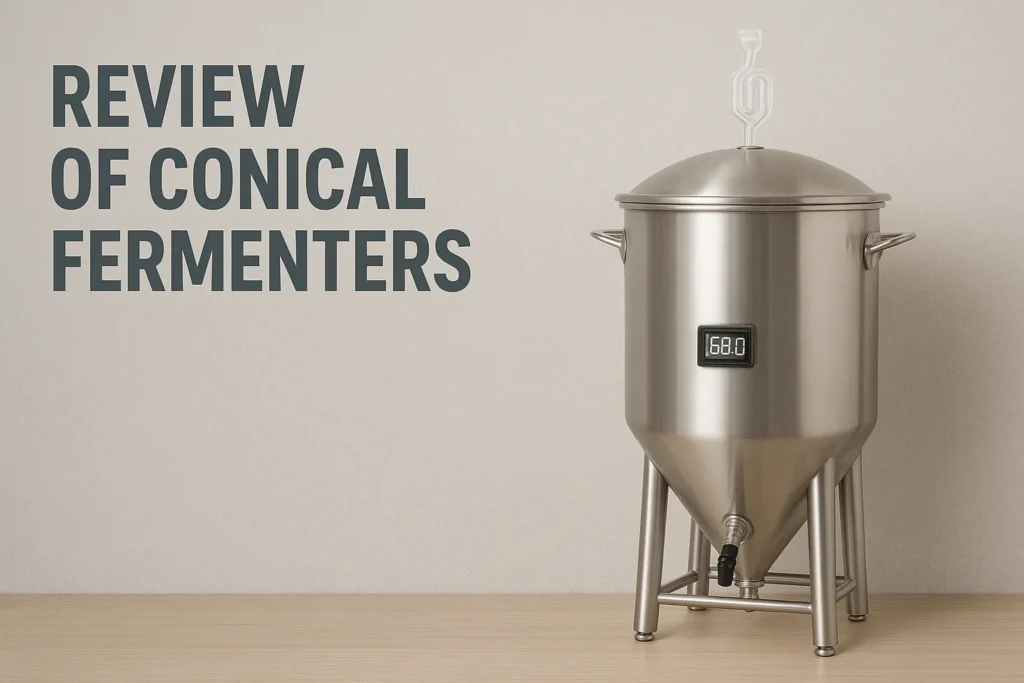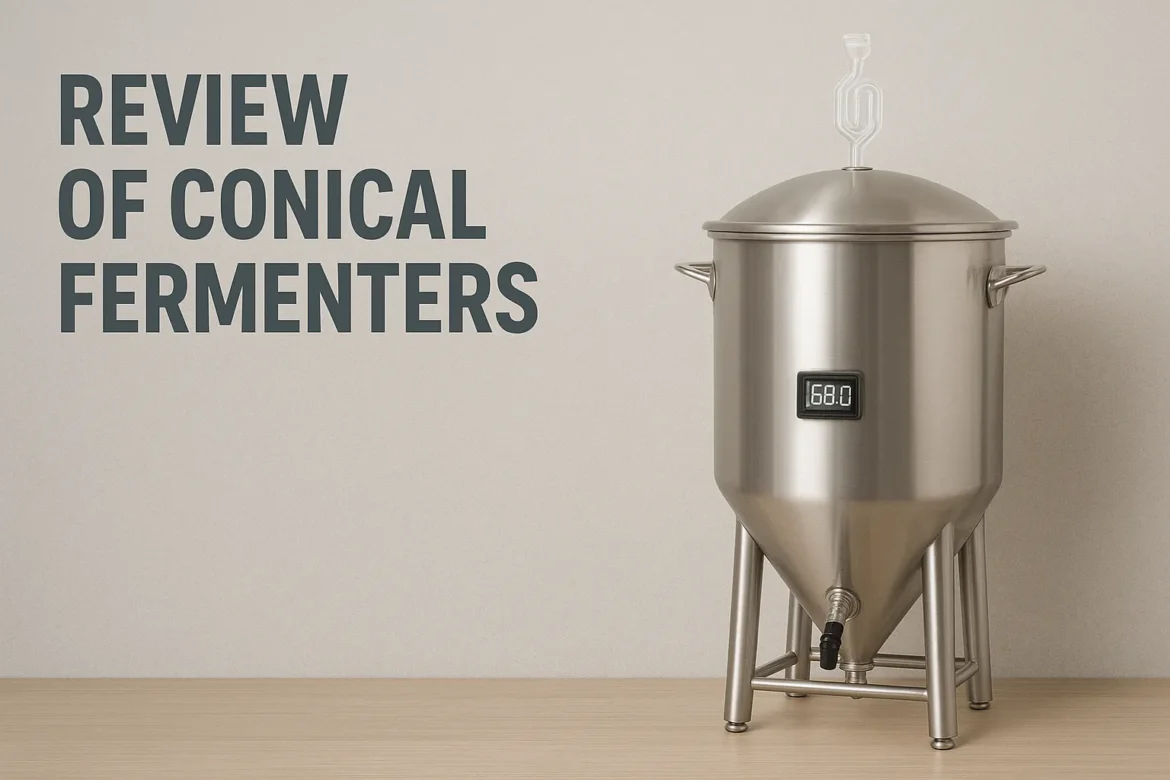Discover the Review of Conical Fermenters pros, cons, and top models of conical fermenters for home and craft brewers. Evaluate stainless steel, plastic, and unitank designs to find the best conical fermenter for consistently clear, professional-grade beer at any scale.

Conical fermenters have long defined the gold standard for fermentation control, clarity, and yeast management in both commercial and homebrewing environments. After a decade of testing and consulting on various fermenter designs, I can confidently say that a well-chosen conical fermenter not only simplifies fermentation logistics but directly improves beer quality, reduces contamination risk, and streamlines the entire brewing process.
My deep dive into conical fermenters started with the pursuit of a professional-quality homebrew and has since encompassed everything from entry-level plastic conicals to pressure-rated stainless steel unitanks. The evolution of these vessels over the last few years—both in the craft industry and at the homebrew level—means today’s conical fermenters are more efficient, hygienic, and adaptable than ever before.
This guide critically reviews the leading conical fermenters in 2025, explaining why their unique design offers more than just a sleek appearance. From ease of yeast harvesting and trub removal to advanced features like temperature control and pressure fermentation, you’ll get a clear look at how to select the right vessel for your brewing ambitions.
Whether you’re an advanced homebrewer looking to scale up—or a hobbyist ready to move beyond buckets and carboys—understanding the features, types, and real-world strengths of conical fermenters will connect you to the next level of brewing control and product clarity.
Why Choose a Conical Fermenter?
The conical fermenter’s core advantage is the cone-shaped bottom: this enables yeast and trub (protein and hop debris) to naturally settle and compact at the point, allowing for simple, repeatable sediment removal. This eliminates the need for frequent racking and mitigates the risk of oxygen exposure and contamination during transfers.yolongbrewtech+2
Key Benefits
- Single-vessel fermentation and conditioning: Enables closed transfers and secondary processes without moving the beer.yolongbrewtech
- Clean yeast harvesting: Collect healthy yeast for repitching or disposal with little disruption.brausupply
- Trub dumping: Quickly remove sediment for clearer beer and brighter flavors.brewcabin
- Integrated sampling and temperature ports: Easily monitor fermentation progress and maintain temperature control for finer-tuned results.micetgroup+1
- Pressure fermentation possibilities: Many modern conicals (especially “unitanks”) allow safe carbonation and pressure transfers in-vessel.yolongbrewtech+1
- Enhanced sanitation and cleaning: Smoother internal surfaces and accessible ports make thorough cleaning fast and simple, reducing infection risk.spikebrewing+1
- Reduced oxidation: Fewer open-air transfers keep beer fresh and bright, especially critical for hop-forward styles.brewcabin+1
Types of Conical Fermenters
Conical fermenters span a wide range of capacities, materials, and costs. The ideal choice depends on your budget, brewing scale, and feature preferences.yolongbrewtech+1
| Fermenter Type | Example Volumes | Typical Features | Pros | Best Suited For |
|---|---|---|---|---|
| Plastic Conicals | 3–15 gallons | Lightweight, translucent | Most affordable, easy to handle | Beginners, pilot batches |
| Stainless Steel Conicals | 6–15+ gallons | Jacketed, pressure-rated | Pro-grade performance, longevity | Advanced homebrewers, microbreweries |
| Unitanks | 6–1000+ gallons | Carb/pressure ready | All-in-one: ferment, carbonate, serve | Commercial/craft breweries |
| Half-barrel Mini Conicals | ~15 gallons | Advanced features | Offers pro features in homebrew size | Serious homebrewers |
Material Matters
- Plastic: Excellent value, lightweight; may be prone to scratching, less durable.brewcabin+1
- Stainless Steel: Durable, easy to sanitize, aesthetically premium, heat/cold stable; higher initial investment, much longer lifespan.micetgroup+2
Top Conical Fermenter Models in 2025
Based on performance, reliability, and user feedback, these are consistently top-rated:
Spike Brewing Conical Series
Pros: Extremely robust, holds up to 15 PSI for pressurized fermentation, outstanding welds and finish, CIP-ready, adaptable ports for add-ons, high resale value.
Cons: Premium pricing; bulky for smaller spaces.
Ss BrewTech Chronical BME
Pros: Reliable pressure capability, domed lid and secure seals, broad aftermarket for accessories (heating, cooling, pressure kits), food-grade welds.
Cons: Fewer built-in cooling options unless upgraded.
FermZilla and FastFerment Plastic Conicals
Pros: Most affordable conical option, lightweight, easy to set up, easy yeast harvesting, clear to watch fermentation.
Cons: Not pressure rated, susceptible to staining and scratching, less insulating.
BrewBuilt X2 & X3 Unitanks
Pros: Mirror polish inside/out, versatile fittings, pressure rated for in-tank carbonation and closed transfer, “pro-feel” construction.
Cons: Expensive at larger sizes; needs add-ons for full temperature control.
KromeBrew 20L Conical (India)
Pros: Stainless construction, ideal for homebrewers in India, cost-effective relative to imports, robust build.kromebrew
Cons: Limited availability of advanced pressure/carbonation functionality.
Review of Conical Fermenters Core Features That Matter
Yeast and Sediment Removal
A true conical lets you drop trub (dead yeast/protein sediment) after primary, then easily harvest healthy yeast after fermentation. This preserves beer clarity, enhances yeast health for future batches, and simplifies cleanup.
Sanitation and Cleaning
Seamless welds and quality materials (especially 304/316 stainless steel) help prevent contamination. Look for wide ports, removable valves, and surfaces that stand up to hot water, chemicals, and brushes.
Temperature Control
Some fermenters come with built-in jackets for chilling and/or glycol cooling—essential for lagers and temperature-sensitive yeasts. Neoprene jackets provide basic insulation, but serious temperature control usually requires additional investment.yolongbrewtech
Pressure Capability
Unitank-style conicals support in-vessel carbonation and fully closed transfers, reducing oxygen pickup and simplifying packaging. Verify pressure ratings before attempting pressure fermentations.
Sampling and Access Ports
Sanitary butterfly valves, sampling cocks, and thermowells simplify quality control, gravity checks, and taking samples without contamination.
Pros and Cons of Conical Fermenters
| Pro | Con |
|---|---|
| Cleaner beer, easier yeast harvesting | Higher upfront cost |
| More sanitary and durable | Heavier; more challenging to move when full |
| Enables closed transfers and pressure fermentation | Takes up more vertical space |
| Easier to clean and maintain | Plastic models can be prone to scratches |
| Reduces oxygen exposure, enhances stability | May require extra equipment (temperature/pressure kits) |
| Versatile add-ons: spunding, cooling, etc. | Stainless steel usually more expensive |
Who Should Invest in a Conical Fermenter?
- Homebrewers committed to quality: Looking to minimize oxidation, simplify process, up their clarity, or harvest/repitch yeast easily.
- Brewers making big, hoppy, or delicate styles: Less oxygen, more flavor retention, and better clarity can make a noticeable difference for NEIPAs, pilsners, or mixed cultures.
- Anyone packaging heavily/carbonating: Pressure-transfer compatibility is a game-changer for those bottling or kegging frequently.
Industry Trends for 2025
- Smaller, pressure-rated conicals for homebrewers are surging in popularity, mirroring the “pro tank at home” movement.
- Integrated smart sensors and Bluetooth monitoring are now standard in many advanced models for temperature, pressure, and all-in-one cellar tracking.
- Energy optimization and advanced coatings (ultra-smooth internal finishes, improved insulation) are pushing cleaning times down and energy use lower.
- Oxygen control and dual-purpose tanks: Modern designs are increasingly pre-setup for closed transfers and DAW (de-aerated water) cleaning.
Buyer’s Guide: How to Choose the Right Conical Fermenter
- Capacity: Pick a size slightly larger than your intended batch to avoid messes (7-gallon conical for a 5-gallon batch).
- Material Quality: Favor 304/316 stainless for durability and hygiene, unless prioritizing low weight or budget.micetgroup
- Pressure Rating: If you want closed transfer or in-tank carbonation, pressure capability is a must.
- Temp Control: Essential for lagers, recommended for consistent quality—look for glycol-ready jackets or integrated cooling.
- Ease of Cleaning: Look for wide access points, polished interiors, CIP compatibility, and replaceable gaskets.
Are Conical Fermenters Worth It?
A well-designed conical fermenter pays for itselfover time by streamlining brewing, slashing oxygen risk, and enabling new techniques for superior beer. While initial costs are higher than buckets or carboys, the benefits in process efficiency, product clarity, and yeast management justify the upgrade for any committed brewer.
Choose your investment based on current and future brewing ambitions: if you plan to package, scale up, or brew delicate/hoppy beers, a pressure-rated stainless conical from a trusted brand (like Ss BrewTech, Spike, or a quality unitank) will transform your fermentations. Value-oriented brewers or newcomers will appreciate the cost and ease of modern plastic conicals, which outperform glass in safety and usability.
About the Author
John Brewster is a passionate homebrewer with over a decade of experience experimenting with different beer styles and fermentation technologies. Known for his in-depth equipment reviews and hands-on testing, John shares practical advice to help brewers choose the best tools for their beer. He specializes in fermentation control, stainless steel cleaning techniques, and optimizing equipment for both clarity and flavor. Reach him at [email protected] or dive into his gear-focused brewing guides and resources at brewmybeer.online.

